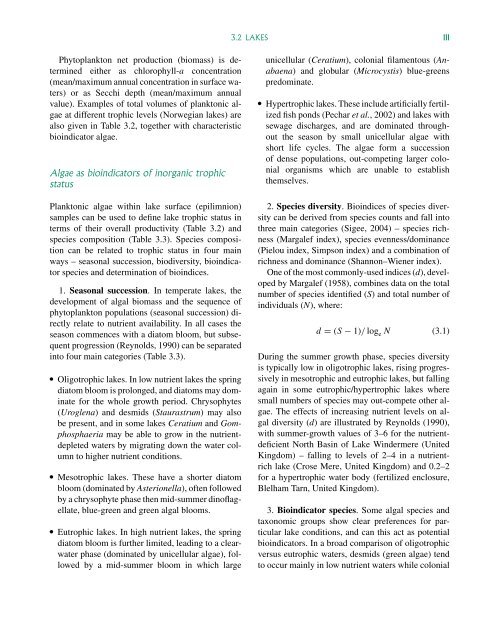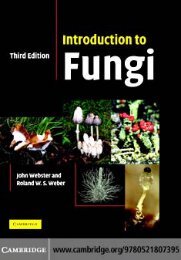Freshwater Algae: Identification and Use as Bioindicators
Freshwater Algae: Identification and Use as Bioindicators
Freshwater Algae: Identification and Use as Bioindicators
Create successful ePaper yourself
Turn your PDF publications into a flip-book with our unique Google optimized e-Paper software.
3.2 LAKES 111Phytoplankton net production (biom<strong>as</strong>s) is determinedeither <strong>as</strong> chlorophyll-a concentration(mean/maximum annual concentration in surface waters)or <strong>as</strong> Secchi depth (mean/maximum annualvalue). Examples of total volumes of planktonic algaeat different trophic levels (Norwegian lakes) arealso given in Table 3.2, together with characteristicbioindicator algae.<strong>Algae</strong> <strong>as</strong> bioindicators of inorganic trophicstatusPlanktonic algae within lake surface (epilimnion)samples can be used to define lake trophic status interms of their overall productivity (Table 3.2) <strong>and</strong>species composition (Table 3.3). Species compositioncan be related to trophic status in four mainways – se<strong>as</strong>onal succession, biodiversity, bioindicatorspecies <strong>and</strong> determination of bioindices.1. Se<strong>as</strong>onal succession. In temperate lakes, thedevelopment of algal biom<strong>as</strong>s <strong>and</strong> the sequence ofphytoplankton populations (se<strong>as</strong>onal succession) directlyrelate to nutrient availability. In all c<strong>as</strong>es these<strong>as</strong>on commences with a diatom bloom, but subsequentprogression (Reynolds, 1990) can be separatedinto four main categories (Table 3.3). Oligotrophic lakes. In low nutrient lakes the springdiatom bloom is prolonged, <strong>and</strong> diatoms may dominatefor the whole growth period. Chrysophytes(Uroglena) <strong>and</strong> desmids (Staur<strong>as</strong>trum) may alsobe present, <strong>and</strong> in some lakes Ceratium <strong>and</strong> Gomphosphaeriamay be able to grow in the nutrientdepletedwaters by migrating down the water columnto higher nutrient conditions. Mesotrophic lakes. These have a shorter diatombloom (dominated by Asterionella), often followedby a chrysophyte ph<strong>as</strong>e then mid-summer dinoflagellate,blue-green <strong>and</strong> green algal blooms. Eutrophic lakes. In high nutrient lakes, the springdiatom bloom is further limited, leading to a clearwaterph<strong>as</strong>e (dominated by unicellular algae), followedby a mid-summer bloom in which largeunicellular (Ceratium), colonial filamentous (Anabaena)<strong>and</strong> globular (Microcystis) blue-greenspredominate. Hypertrophic lakes. These include artificially fertilizedfish ponds (Pechar et al., 2002) <strong>and</strong> lakes withsewage discharges, <strong>and</strong> are dominated throughoutthe se<strong>as</strong>on by small unicellular algae withshort life cycles. The algae form a successionof dense populations, out-competing larger colonialorganisms which are unable to establishthemselves.2. Species diversity. Bioindices of species diversitycan be derived from species counts <strong>and</strong> fall intothree main categories (Sigee, 2004) – species richness(Margalef index), species evenness/dominance(Pielou index, Simpson index) <strong>and</strong> a combination ofrichness <strong>and</strong> dominance (Shannon–Wiener index).One of the most commonly-used indices (d), developedby Margalef (1958), combines data on the totalnumber of species identified (S) <strong>and</strong> total number ofindividuals (N), where:d = (S − 1)/ log e N (3.1)During the summer growth ph<strong>as</strong>e, species diversityis typically low in oligotrophic lakes, rising progressivelyin mesotrophic <strong>and</strong> eutrophic lakes, but fallingagain in some eutrophic/hypertrophic lakes wheresmall numbers of species may out-compete other algae.The effects of incre<strong>as</strong>ing nutrient levels on algaldiversity (d) are illustrated by Reynolds (1990),with summer-growth values of 3–6 for the nutrientdeficientNorth B<strong>as</strong>in of Lake Windermere (UnitedKingdom) – falling to levels of 2–4 in a nutrientrichlake (Crose Mere, United Kingdom) <strong>and</strong> 0.2–2for a hypertrophic water body (fertilized enclosure,Blelham Tarn, United Kingdom).3. Bioindicator species. Some algal species <strong>and</strong>taxonomic groups show clear preferences for particularlake conditions, <strong>and</strong> can this act <strong>as</strong> potentialbioindicators. In a broad comparison of oligotrophicversus eutrophic waters, desmids (green algae) tendto occur mainly in low nutrient waters while colonial
















